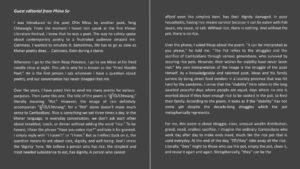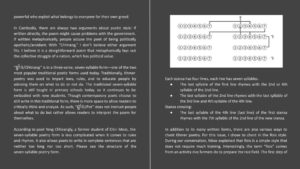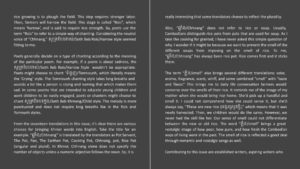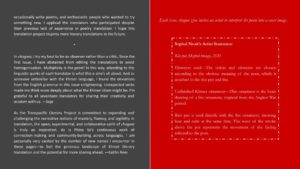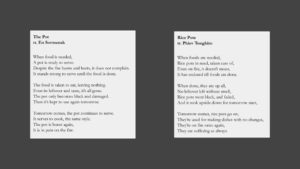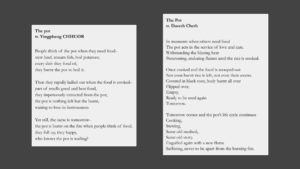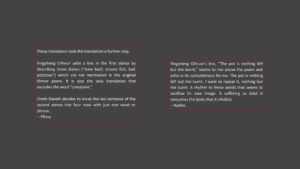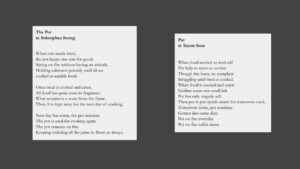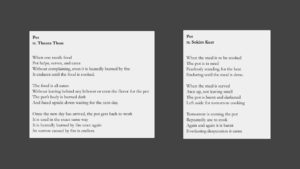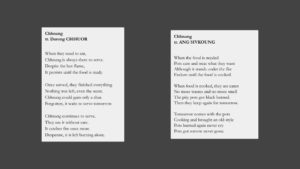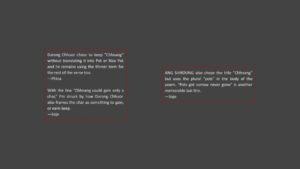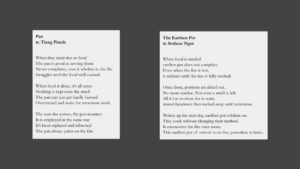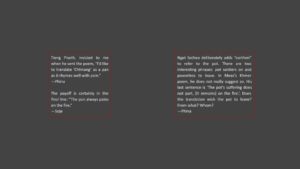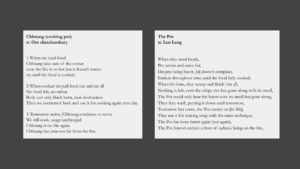Without rice, there is nothing. And without the pot, there is no rice.
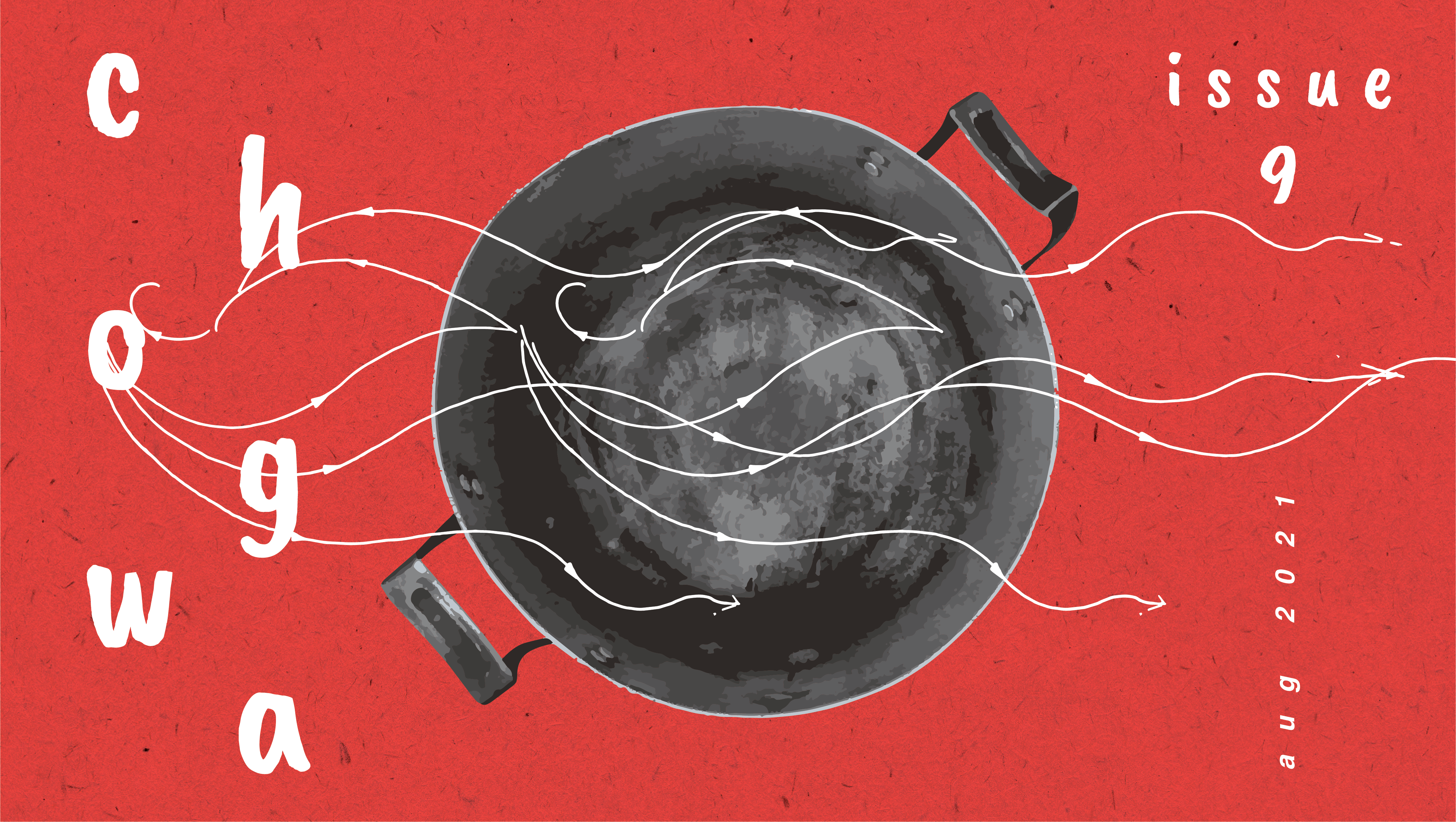
August 25, 2021
Editor’s note: chogwa is a quarterly e-zine featuring one poem and multiple English translations. Edited by Soje, chogwa typically features a Korean language poem. Yet for this special guest-edited issue in collaboration with the Transpacific Literary Project, Cambodian poet Phina So selected a Khmer language poem to invite a multitude of English translations.
Click here to download and print this issue of chogwa directly
And click here to read a plain text version of the zine
Guest editorial from Phina So
I was introduced to the poet Chin Meas by another poet, Yeng Chheangly. From the moment I heard him speak at the first Khmer Literature Festival, I knew that he was a poet. The way he calmly spoke about contemporary poetry to a frustrated audience amazed me. Calmness. I wanted to emulate it. Sometimes, life has to go as slow as Khmer poetry does… Calmness. Even during a storm.
Whenever I go to the Siem Reap Province, I go to see Meas at his fried noodle shop at night. This job is why he is known as the “Fried Noodle Poet.” He is the first person I ask whenever I have a question about poetry, and our conversation has never disappointed me.
Over the years, I have asked him to send me many poems for various purposes. Then came this one. The title of the poem is “ឆ្នាំង/Chhnang,” literally meaning “Pot.” However, the image of rice definitely accompanies “ឆ្នាំង/Chhnang”, for a “Pot” alone doesn’t make much sense to Cambodians. Rice is something we eat three times a day. In the Khmer language, in everyday conversation, we don’t ask each other about breakfast, lunch, or dinner without adding the word “rice.” To be honest, I hear the phrase “Have you eaten rice?” and take it for granted. I simply reply with “I haven’t” or “I have.” But as I reflect back on it, the question means to ask about care, dignity, and well-being. And I stress the ‘dignity’ here. We believe a person who has rice, the simplest and most needed subsistence to eat, has dignity. A person who cannot afford even this simplest item, has their dignity damaged. In poor households, having rice means survival because it can be eaten with fish sauce, soy sauce, or salt. Without rice, there is nothing. And without the pot, there is no rice.
Over the phone, I asked Meas about the poem. “It can be interpreted as you please,” he told me. “The Pot refers to the struggles and the sacrifice of Cambodians through various generations, who survived by securing rice pots. However, their wishes for stability have never been met.” My own interpretation of the image is the struggle of the poet himself. As a knowledgeable and talented poet, Meas and his family survive by being street food vendors in a touristy province that was hit hard by the pandemic. I sense that the “stability” here refers to the long awaited peaceful days where people are equal, days where no one is worried about if they have enough rice to be cooked in the pot, to feed their family. According to the poem, it looks as if the “stability” has not come yet despite the decade-long struggles which the pot metaphorically represents.
For me, this poem is about struggle, class, unequal wealth distribution, greed, need, endless sacrifice. I imagine the ordinary Cambodians who work day after day to make ends meet, much like the rice pot that is used everyday. At the end of the day, “គេ/they” take away all the rice. Literally, “they” might be those who use the pot, empty the pot, clean it, and reuse it again and again. Metaphorically, “they” can be the powerful who exploit what belongs to everyone for their own greed.
In Cambodia, there are always two arguments about poetic style: if written directly, the poem might cause problems with the government. If written metaphorically, people accuse the poet of being politically apathetic/avoidant. With “Chhnang,” I don’t believe either argument fits. I believe it is a straightforward poem that metaphorically lays out the collective struggle of a nation, which has political value.
“ឆ្នាំង/Chhnang” is in a three-verse, seven-syllable form—one of the two most popular traditional poetic forms used today. Traditionally, Khmer poetry was used to impart laws, rules, and to educate people by advising them on what to do or not do. The traditional seven-syllable form is still taught in primary schools today, so it continues to be embodied with new students. Though contemporary poets choose to still write in this traditional form, there is more space to allow readers to critically think and analyze. As such, “ឆ្នាំង/Pot” does not instruct people about what to do but rather allows readers to interpret the poem for themselves.
According to poet Yeng Chheangly, a former student of Chin Meas, the seven-syllable poetry form is less complicated when it comes to rules and rhymes. It also allows poets to write in complete sentences that are neither too long nor too short. Please see the structure of the seven-syllable poetry form.
Each stanza has four lines, each line has seven syllables.
- The last syllable of the first line rhymes with the 2nd or 4th syllable of the 2nd line.
- The last syllable of the 2nd line rhymes with the last syllable of the 3rd line and 4th syllable of the 4th line.
Stanza crossing:
- The last syllable of the 4th line (last line) of the first stanza rhymes with the 7th syllable of the 2nd line of the new stanza.
In addition to its many written forms, there are also various ways to chant Khmer poetry. For this issue, I chose to chant in the Rois style. During our conversation, Meas explained that Rois is a simple style that does not require much training. Interestingly, the term “Rois” comes from an activity rice farmers do to prepare the rice field. The first step of rice growing is to plough the field. This step requires stronger labor. Then, farmers will harrow the field. This stage is called “Rois”, which means ‘harrow’, and is said to require less strength. So, poets use the term “Rois” to refer to a simple way of chanting. Considering the neutral voice of “Chhnang,” សូត្របែបរាស់/Soth Beb Rois/Harrow style seemed fitting to me.
Poets generally decide on a type of chanting according to the meaning of the particular poem. For example, if a poem is about sadness, the សូត្របែបរាស់/Soth Beb Rois/Harrow Style wouldn’t be appropriate. Poets might choose to chant ‘ទំនួញ/Tomnounh, which literally means the ‘Crying’ style. The Tomnounh chanting style takes long breaths and sounds a lot like a person is crying and naming that which makes them sad. In some poems that are intended to educate young children and want children to be easily engaged, poets or chanters might choose to chant សូត្របែបក្មេង/Soth Beb Khmeng/Child style. The melody is more punctuated and does not require long breaths like in the Rois and Tomnunh styles.
From the seventeen translations in this issue, it’s clear there are various choices for bringing Khmer words into English. Take the title for an example. “ឆ្នាំង/Chhnang” is translated by the translators as Pot Servant, The Pot, Pan, The Earthen Pot, Cooking Pot, Chhnang, pot, Rice Pot (singular and plural). In Khmer, Chhnang alone does not specify the number of objects unless a numeric adjective follows the noun. So, it is really interesting that some translators choose to reflect the plurality.
Also, “ឆ្នាំង/Chhnang” does not refer to rice or soup. Usually, Cambodians distinguish rice pots from pots that are used for soup. As I take the cooking for granted, I have never asked this simple question of why. I wonder if it might be because we want to prevent the smell of the different soups from imposing on the smell of rice. To me, “ឆ្នាំង/Chhnang” has always been rice pot. Rice comes first and it sticks there.
The term “ក្លិន/smell” also brings several different translations: odor, aroma, fragrance, scent, whiff, and some combined “smell” with “taste and flavor.” This brings me to daily life conversation farmers would converse over the smells of their rice. It reminds me of the image of my mother when she would bring rice home. She’d pick up a handful and smell it. I could not comprehend how she could sense it, but she’d always say, “These are new rice (អង្ករស្រូវថ្មី),” which means that it was newly harvested. Then, we children would do the same. However, we never had the skill like her. Our sense of smell could not differentiate between the new or old rice. The word “ក្លិន/smell” brings a great nostalgic image of how poor, how pure, and how fresh the Cambodian ways of living were in the past. The smell of rice is reflected a good deal through romantic and nostalgic songs as well.
Contributing to this issue are established writers, aspiring writers who occasionally write poems, and enthusiastic people who wanted to try something new. I applaud the translators who participated despite their previous lack of experience in poetry translation. I hope this translation project inspires more literary translations in the future.
***
In chogwa, I try my best to be an observer rather than a critic. Since the first issue, I have abstained from editing the translations to avoid homogenization. Multiplicity is the point! In this way, attending to the linguistic quirks of each translator is what this e-zine’s all about. And as someone unfamiliar with the Khmer language, I found the deviations from the English grammar in this issue enlightening. Unexpected verbs made me think more deeply about what the Khmer idiom might be. I’m grateful to all seventeen translators for sharing their creativity and wisdom with us. —Soje
***
As the Transpacific Literary Project is committed to expanding and challenging the normative notions of mastery, fluency, and legibility in translation, the open, experimental, and collaborative spirit of chogwa is truly an inspiration. As is Phina So’s continuous work of connection-making and community-building across languages. I am personally very excited by the number of new names I encounter in these pages—to feel the generous landscape of Khmer literary translation and the potential for more sharing ahead. —Kaitlin Rees
***
Each issue, chogwa zine invites an artist to interpret the poem into a cover image.
Sophal Neak’s Artist Statement
Rice pot, Digital image, 2021
Elements used—The colors and elements are chosen according to the obvious meaning of the poet, which is attached to the rice pot and fire.
Unfinished Khmer ornament—This ornament is the basic drawing of a fire ornament, it is inspired from the Angkor Wat period.
Rice pot is used directly with the fire ornament, it’s showing heat and calm at the same time. The waves of the smoke above the pot represent the movement of the feeling the poet refers to.
***
ឆ្នាំង / ជិន មាស
ពេលគេត្រូវការម្ហូបអាហារ
ឆ្នាំងយកអាសារបម្រើថែ
ទោះភ្លើងឆេះក្តៅមិនត្អូញត្អែរ
ស៊ូទ្រាំលុះតែម្ហូបបាយឆ្អិន។
ពេលឆ្អិនគេដួសយកហូបអស់
ក្តាំងកាកគ្មានសោះអស់ទំាងក្លិន
ខ្លួនបានត្រឹមខ្លោចខ្មៅហោចហិន
រួចគេផ្កាប់សិនស្អែកដាំទៀត។
ថ្ងៃស្អែកមកដល់ឆ្នាំងបន្ត
គេយកដាំស្លមិនប្តូរស្នៀត
ឆ្នាំងត្រូវភ្លើងឆេះសារថ្មីទៀត
ឆ្នាំងទុក្ខឥតឃ្លាតនៅលើភ្លើង។
Chhnang / Chin Meas
Pel ke trov ka mahob ahar
Chhnang yok asar bam-roeur thae
Tus phloeung chhes kdao men ta-onh ta-er
Sou troim lus te mahob bay chha-en.
Pel chha-en ke dus yok hob os
Kdaing kak khmean sos os taing khlen
Khlaun ban throem khloach khmao hoch hen
Rouch ke phkab sen sa-ek dam tiet.
Thngai sa-ek mok dol Chhnang ban-tor
Ke yok dam slor men bdo sniet
Chhnang trov phloeung chhes sar thmey tiet
Chhnang tuk eit khliet nov leu phloeung.
✨ Listen to Phina So chant and read the poem ✨
The Pot
tr. En Sormanak
When food is needed,
A pot is ready to serve.
Despite the fire burns and hurts, it does not complain.
It stands strong to serve until the food is done.
The food is taken to eat, leaving nothing.
Even its leftover and taste, it’s all gone.
The pot only becomes black and damaged.
Then it’s kept to use again tomorrow.
Tomorrow comes, the pot continues to serve.
It serves to cook, the same style.
The pot is burnt again,
It is in pain on the fire.
There is a concrete verb in the original Khmer poem in the last line of the second verse which is ផ្កាប់ or to be flipped over or upside down. When this verb is used with a pot or a plate, it means that the item is no longer in use or at least not for a while. In Sormanak’s translation, he keeps the last line of the second verse simple: “is kept.” This makes me wonder if the translator would like to honor the pot and avoid an expression that would humiliate the pot. According to Sormanak, the pot is kept (perhaps nicely?) to be used again tomorrow. The two last sentences strike a chord with me: “the pot is burnt again, it is in pain on the fire.” —Phina
Rice Pots
tr. Phiev Tonghim
When foods are needed,
Rice pots in need, taken care of,
Even on fire, it doesn’t moan,
It has endured till foods are done.
When done, they ate up all,
No leftover left without smell,
Rice pots went black, and faded,
And it took upside down for tomorrow start,
Tomorrow comes, rice pots go on,
They’re used for making dishes with no changes,
They’re on fire once again,
They are suffering as always.
As Phina mentioned in her editorial, the Khmer language allows for “Chhnang” to be singular or plural. While En Sormanak identifies a single pot, Phiev Tonghim imagines a collective of pots and even pluralizes the food(s) cooked by them.—Soje
Pot Servant
tr. Phacdey Vireakboth
Empty needs me nutrients your soul.
Pot is the soul of your starving.
Creatures hurt-free, but delicious mouthful.
Of course, one thing to fertile manlife.
Finished no left to serve for self.
No smell, no serve, die free for you.
All time menu for your hollow.
Come back to me, continues rusty bottom.
Tomorrow returns, pot again works hard.
Rusty takes hard like yesterday.
Nutrient evils both day and night.
The rest of life, free serve man-empty.
Phacdey Vireakboth, interestingly, uses the pronouns “me” and “you.” —Phina
Phacdey Vireakboth’s “pot is the soul of your starving” and later “menu for your hollow” leave me agape. I like how the images suggest a reversal of animacy between the vacant consumer and the soulful vessel of consumption. —Kaitlin
pot
tr. June Pen
when food is needed
i take care of it
even over a blazing fire i do not complain
i endure until the food is cooked
when the rice is cooked it gets scooped away
no crust, not even a whiff is left behind
i am scorched and scarred
i get flipped upside-down until the next day
when tomorrow arrives i resume my work
i am used with an unchanged technique
the fire hits me once again
and i toil over the flames without end
June Pen goes beyond personifying the titular pot by rendering the poem in the first person, which certainly raises the stakes in a line like “i toil over the flames without end” and resonates with Phina’s interpretation of the pot representing the Fried Noodle Poet himself. —Soje
The pot
tr. Yingpheng CHHUOR
People think of the pot when they need food–
stew beef, stream fish, boil potatoes;
every dish they fond of,
they burnt the pot to boil it.
Then they rapidly ladled out when the food is cooked–
part of smells good and best food,
they impetuously extracted from the pot;
the pot is nothing left but the burnt,
waiting to lose its lustrousness.
Yet still, the same is tomorrow–
the pot is burnt on the fire when people think of food.
they full up, they happy,
who knows the pot is wailing?
Yingpheng Chhour adds a line in the first stanza by describing three dishes (“stew beef, stream fish, boil potatoes”) which are not mentioned in the original Khmer poem. It is also the only translation that excludes the word “complaint.” —Phina
Yingpheng Chhuor’s line, “The pot is nothing left but the burnt,” seems to rise above the poem and echo in its completeness for me. The pot is nothing left but the burnt. I want to repeat it, nothing but the burnt. A rhythm to these words that seems to swallow its own image. A suffering so total it consumes the body that it inhabits. —Kaitlin
The Pot
tr. Daveth Cheth
In moments when others need food
The pot acts in the service of love and care.
Withstanding the blazing heat
Persevering, enduring flames until the rice is cooked.
Once cooked and the food is scooped out
Not even burnt rice is left, not even their aroma.
Covered in black soot, body burnt all over
Flipped over,
Empty,
Ready to be used again
Tomorrow.
Tomorrow comes and the pot’s life cycle continues
Cooking,
Stewing,
Same old method,
Same old story.
Engulfed again with a new flame
Suffering, never to be apart from the burning fire.
Cheth Daveth decides to break the last sentence of the second stanza into four rows with just one word or phrase. —Phina
The Pot
tr. Soksophea Suong
When one needs food,
the pot keeps one care for good.
Sitting on fire without having an attitude.
Holding calmness patently until all are
cooked as eatable food.
Once meal is cooked and eaten.
All food has gone even its fragrance.
What remains is a scare from the flame.
Then, it is kept away for the next day of cooking.
New day has come, the pot remains.
The pot is used for cooking again.
The pot remains on fire.
Keeping enduring all the pains in flame as always.
Soksophea Soung didn’t take this translation lightly. She told me, I shall give it a try. She delivered her promise with rhythmic words and still keeps the original meaning of the Khmer poem. —Phina
Pot
tr. Sayon Sous
When food needed to feed self
Pot help to serve to service
Though fire burn, no complain
Struggling until food is cooked.
When food is cooked and eaten
Neither waste nor smell left
Pot has only tragedy self.
Then pot is put upside down for tomorrow cook.
Tomorrow come, pot continue
Gotten into same duty
Pot on fire everyday
Pot on fire suffer most.
The compact spacing in Sayon Sous’s translation weights the poem and the pot with a particular heaviness I feel. —Kaitlin
That Sayon Sous’s translation begins with “When food needed to feed self” and gives us the punctuated line “Pot has only tragedy self.” just guts me. —Soje
Cooking Pot
tr. Kim Heng Choeurn
When they need meal cooking pot is there to serve
Even it gets burning, shows no complaint it holds on till the food got well done.
Soon when it cooked, food was eaten up Not even the overcook pieces were left, nor the taste of smell
Cooking Pot only be left with black scar of burn and set to wait till tomorrow to serve again.
When tomorrow comes it’s service be continued not a single change they use this Cooking Pot,
Be burn again that is what it it got. This is the forever pain to a Cooking Pot, life on fire
Kim Heng’s translation is unique. She chose to translate the poem according to the structure of the 7 syllable form. If you have a close look at the poem’s structure, it is written from left to right and then enter a space before starting another sentence. Then, enter and add another two final sentences following the same structure. This might confuse English readers though. —Phina
Pot
tr. Theara Thun
When one needs food
Pot helps, serves, and cares
Without complaining, even it is heatedly burned by fire
It endures until the food is cooked.
The food is all eaten
Without leaving behind any leftover or even the flavor for the pot
The pot’s body is burned dark
And faced upside down waiting for the next day.
Once the new day has arrived, the pot gets back to work
It is used in the exact same way
It is heatedly burned by fire once again
Its sorrow caused by fire is endless.
Theara Thun’s simple use of the preposition “for” in the line noting there remains not even the flavor of food left “for the pot” creates a surprising space for desire and pleasure within the pot. —Kaitlin
Pot
tr. Sokim Keat
When the meal is to be cooked
The pot is in need
Fearlessly standing for the heat
Enduring until the meal is done.
When the meal is served
Aten up, not leaving smell
The pot is burnt and darkened
Left aside for tomorrow cooking
Tomorrow is coming the pot
Repeatedly use to cook
Again and again it is burnt
Everlasting desperation it earns
Sokim Keat’s last line “Everlasting desperation it earns” reminds me of the idiom to earn keep, or “to perform sufficient work or help in exchange for money or housing.” As if desperation is the only thing earned by having a job. —Soje
Chhnang
tr. Darong CHHUOR
When they need to eat,
Chhnang is always there to serve.
Despite the hot flame,
It persists until the food is ready.
Once served, they finished everything.
Nothing was left, even the scent.
Chhnang could gain only a char.
Forgotten, it waits to serve tomorrow.
Chhnang continues to serve.
They use it without care.
It catches fire once more.
Desperate, it is left burning alone.
Darong Chhuor chose to keep “Chhnang” without translating it into Pot or Rice Pot and he remains using the Khmer term for the rest of the verse too. —Phina
With the line “Chhnang could gain only a char,” I’m struck by how Darong Chhuor also frames the char as something to gain, or earn keep. —Soje
Chhnang
tr. ANG SIVKOUNG
When the food is needed
Pots care and treat what they want
Although it stands under the fire
Endure until the food is cooked.
When food is cooked, they are eaten
No more wastes and no more smell
The pity pots got black burned.
Then they keep again for tomorrow.
Tomorrow comes with the pots
Cooking and brought an old-style
Pots burned again never cry
Pots got sorrow never gone.
ANG SIVKOUNG also chose the title “Chhnang” but uses the plural “pots” in the body of the poem. “Pots got sorrow never gone” is another memorable last line. —Soje
Pan
tr. Tieng Piseth
When they need rice or food
The pan is good at serving them
Never complains, even it whelms in the fire
Struggles until the food well cooked.
When food is done, it’s all eaten
Nothing is kept even the smell
The pan can just get hardly burned
Overturned and waits for tomorrow work.
The new day comes, the pan resumes
It is employed in the same way
It’s been replayed and reburned
The pan always pains on the fire.
Tieng Piseth, insisted to me when he sent the poem, “I’d like to translate ‘Chhnang’ as a pan as it rhymes well with pain.” —Phina
The payoff is certainly in the final line: “The pan always pains on the fire.” —Soje
The Earthen Pot
tr. Sothear Nget
When food is needed
earthen pot does not complain.
Even when the fire is hot,
it endures until the rice is fully cooked.
Once done, portions are doled out.
No more residue. Not even a smell is left.
All it has to show for is scars,
stored facedown then tucked away until tomorrow.
Woken up the next day, earthen pot soldiers on.
They cook without changing their method.
It encounters the fire once more.
This earthen pot of sorrow is on fire, powerless to leave.
Nget Sothea deliberately adds “earthen” to refer to the pot. There are two interesting phrases: pot soldiers on and powerless to leave. In Meas’s Khmer poem, he does not really suggest so. His last sentence is ‘The pot’s suffering does not part, [It remains] on the fire.’. Does the translation wish the pot to leave? From what? Whom? —Phina
Chhnang (cooking pot)
tr. Om chetchanthary
1-When we need food
Chhnang take care of the owner
even the fire is so hot but it doesn’t matter
try until the food is cooked.
2-When cooked we pull food out and eat all
No food left, no odour
Body just only black burn, near destruction
Then we overturn it back and use it for cooking again next day.
3-Tomorrow arrive, Chhnang continues to serve
We still cook, usage unchanged
Chhnang is on fire again
Chhnang has pain not far from the fire.
Om chetchanthary’s line “Body just only black burn, near destruction” stays with me for its imagery and slantest of rhyme between “burn” and “destruction.” —Soje
The Pot
tr. Len Leng
When they need foods,
Pot serves and cares for,
Despite being burnt, [it] doesn’t complain,
Endure throughout time until the food fully cooked,
When it’s done, they scoop and finish ‘em all,
Nothing is left, even the crispy rice has gone along with its smell,
The Pot could only bear the burnt even its smell has gone along,
Then they wash, putting it down until tomorrow,
Tomorrow has come, the Pot carries on [its life],
They use it for making soup with the same technique,
The Pot has been burnt again (not again),
The Pot forever endure a river of sadness being on the fire,
Len Leng’s use of brackets and parentheses add rhythm and a sense of what might be hiding in the Khmer language. I think “The Pot carries on [its life]” is just a beautiful use of punctuation. —Kaitlin


